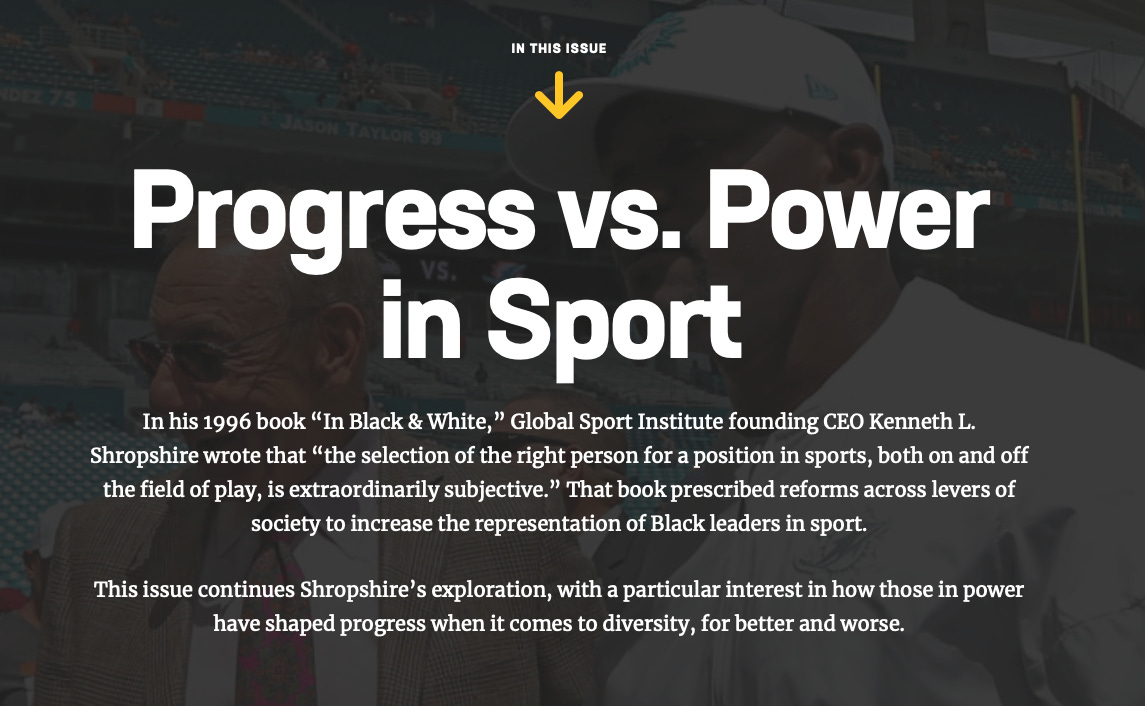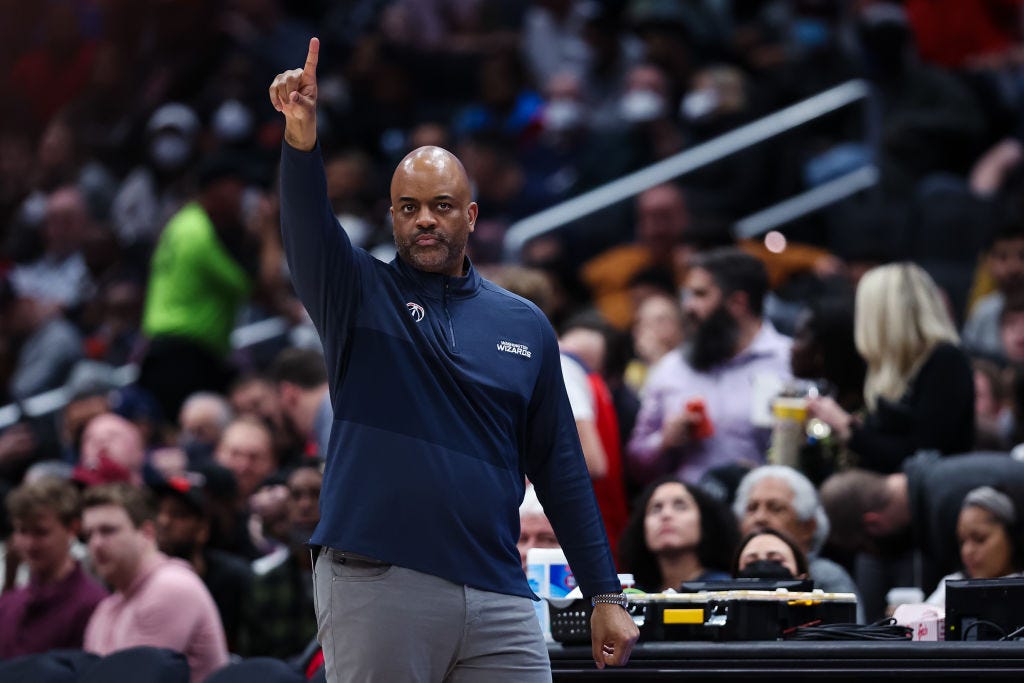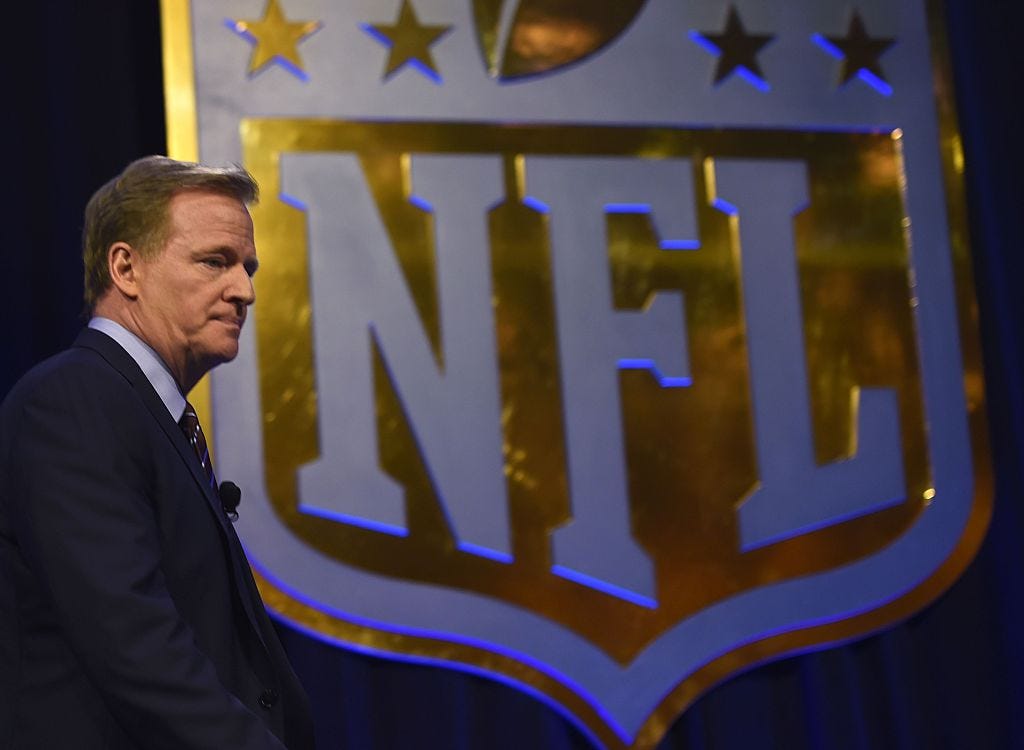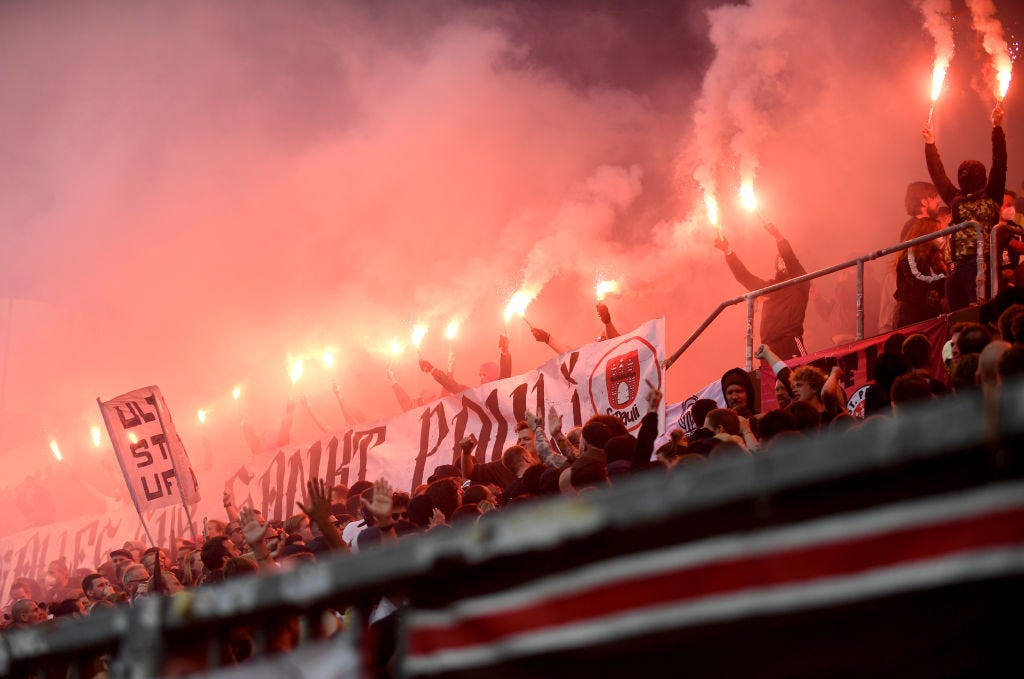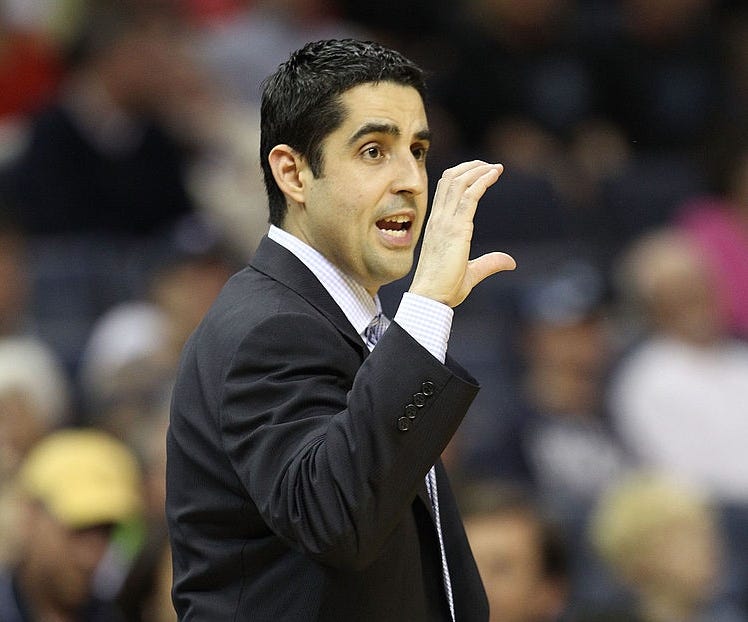Global Sport Matters: The Progress vs. Power Issue
How the NBA is (and isn't) opening doors to diverse coaches, stalled progress in diversifying sports team ownership, soccer fans against global capitalism, and Year 1 of the WCC's "Russell Rule."
Welcome to Hreal Sports, a newsletter written by Patrick Hruby about sports things that don’t stick to sports. Sign up and tell your friends!
Welcome back! I’m delighted to share stories from the August issue of Global Sport Matters, the digital publication of the Global Sport Institute at Arizona State University. For those of you who are unfamiliar with our work, we cover a wide range of outside the lines, sports and society topics though original research and reporting, and via podcasts, live events, standalone articles, and monthly themed issues.
Our August issue is devoted to progress versus power in sports. In his 1996 book “In Black & White: Race and Sports in America,” Global Sport Institute founder Ken Shropshire examined and explored the relative lack of diversity in front offices and ownership suites across American sports—arguing that the sports world has a responsibility to be a leader in the fight for racial equality, and offering strategies for how to do so. A quarter-century later, what kind of progress toward diversity and inclusion has been made? And does that progress extend to who ultimately calls the shots in sports?
Our issue attempts to provide answers. Links and summaries are below for stories on how the NBA is—and isn't—opening doors to diverse coaches, stalled progress in diversifying sports team ownership, soccer fans revolting against the unchecked power of global capitalism, and Year 1 of the West Coast Conference’s "Russell Rule," which aims to break down barriers for diverse leadership candidates in college sports. Hope you enjoy!
“How the NBA Opens Doors for Diverse Coaches Without its Own ‘Rooney Rule,’” by Katie Heindl.
Heading into its upcoming season, half of the NBA's coaches are Black. For a league that is made up largely of Black athletes, this is a meaningful milestone. But there's no guarantee this proportion remains, and women coaches of all races have had a much more challenging time pushing for opportunities.
Since the 1990s, the NBA has hovered around 30% head coaches of color, compared with 83% players of color.
Recently, however, those numbers have started to change. At the start of the 2021-2022 season, the NBA had 16 coaches of color, 13 of whom were Black. As of June 2022, half of the league’s franchises had Black head coaches, a meaningful and important benchmark. The Institute for Diversity and Ethics in Sport (TIDES), a part of the University of Central Florida, publishes annual studies on the racial and gender hiring practices in amateur and professional sports. TIDES awarded the NBA an A grade for the overall racial and gender composition of its coaching, front office, and league office hiring when compared to overall U.S. demographics in 2022 – second only to the Women’s National Basketball Association, which had an overall grade of A-plus.
Unlike the NFL, which uses the Rooney Rule in interviewing candidates for head coaching and senior football operations jobs to encourage racial and gender diversity in hiring (and scored a B in TIDES 2021 study), the NBA has no formalized, league-wide rule for hiring coaches or front office staff. Still, out of the major North American pro leagues, the NBA has recently established one of the best records on diverse, equitable, and inclusive hiring practices for its head coaches. This shift is promising but also requires further maintenance, ranging from initiatives on the part of the league and its coaches to continued pressure from those who want to see further progress in representation and opportunity for all kinds of coaches.
“As 'More of a Movement' Forms Around Diversity in Sports Leadership, Progress is Stalling,” by Shalise Manza Young.
The diversification of sports leadership in the 21st century has been noticeable but not substantial, despite public pressure and rules encouraging diverse hiring in several major sports leagues. As those rules show cracks and major sport increasingly becomes the sandbox of the extremely wealthy, it's hard to see how the situation will improve for women and people of Color.
Perhaps the most important thing to remember in all of this: Whoever has the gold makes the rules. The people who hire the team presidents, general managers, and head coaches, the team owners, are almost exclusively White, with NBA legend Michael Jordan currently the only Black majority-owner of a team in American sports.
Jordan may not be alone much longer. NBA superstar LeBron James has said he wants to own a league expansion team in Las Vegas, and one longtime reporter said recently that James is in “pole position” for that to happen. Earlier in 2022, Forbes declared James a billionaire for the first time, making him the first active athlete to reach that milestone. The 37-year-old, who is gearing up for his 20th NBA season, has earned his money not only through salaries and endorsement money but also through entrepreneurship: His SpringHill production company has been valued at $725 million. James already ownssmall stakes in MLB’s Red Sox and English Premier League soccer club Liverpool.
There have been other Black athletes who have entered into the ownership ranks in recent years. Grant Hill owns a stake in the NBA’s Atlanta Hawks and is vice-chairman of the team’s board; in 2021, Dwyane Wade bought into the Utah Jazz. It’s unclear how big each man’s stake is, but NBA rules stipulate that all new owners must buy at least 1 percent. Renee Montgomery, a two-time WNBA champion, is part of the group that purchased that league’s Atlanta Dream last year.
But one transaction this year virtually guaranteed that in the NFL, the exclusive majority owners’ club will never include a Black person: The Broncos were sold for the astronomical price of $4.65 billion to Rob Walton (son of Walmart founder Sam Walton), who has an estimated net worth of $60 billion. That was nearly double what the Carolina Panthers went for in 2018.
According to Forbes, there are about 2,300 billionaires in the world. Roughly one-third of them live in the U.S. But only 15 are Black, nine of those American, and none is worth more than $6 billion. That is an incredible amount of wealth. But considering the NFL requires principal owners to have at least a 30 percent stake in the team, there are three people of African descent on Earth who have the kind of capital to buy 30 percent of a nearly $5 billion team. While several Black entertainers have entered the billionaire ranks in recent years, these rising prices mean it’s hard to feel good about the chances of America’s biggest league having a Black majority owner any time soon.
“‘Nobody Wants That’: How Soccer Fans Are Rebelling Against Unchecked Global Capitalism,” by Leander Schaerlaeckens.
In the U.S. and Europe, soccer supporters are taking back control of their clubs to keep them pure of greed, violence and other social ills.
At a time when the sport has been hollowed out by cynicism — symptomized by the failed-but-not-dead European Super League; a mid-season World Cup in a rich but very arguably unsuitable host nation; and clubs’ shameless association with gambling companies and cryptocurrency scams—some clubs, often spurred on by their fans, are refusing to assimilate. They are rethinking what a club is, how its ownership structure should work, and what its priorities ought to be. Under pressure from its supporters, Watford recently canceled a friendly with the Qatar national team over the country’s human rights record.
F.C. United of Manchester may have pioneered this push-back against the sport’s unquenchable commercialism.
In 2005, long before it became common, or even inevitable, for a foreign billionaire to own your Premier League team, the Floridian Glazer family — possessed of a portfolio of failing shopping malls, the Tampa Bay Buccaneers, and no apparent interest in soccer — completed a highly-leveraged hostile takeover of Manchester United. They followed their mall model, saddling the debt-free club with hundreds of billions of pounds in loans — liabilities that have barely shrunk as the Glazer family has siphoned money out of the club in spite of its enormous debt.
To one group of prescient fans, it was the final straw. They had been put off by the sanitizing of the matchday experience — a particular flashpoint was a mid-1990s stadium announcement that anybody who stood during the game would be ejected, disregarding a century of convention. They had also been driven away by United’s rather successful foray into the stock market in 1991, when it became just the second EPL club to float stock and made a killing in the process, setting a trend. So they broke off and formed a new team — same colors, similar badge, built on the city of Manchester’s crest with more or less the same name, rearranging the words.
“We were just sick to death of the money men in football dictating how we were to support our club,” says George Baker, a former Manchester United board member. “We knew that would be the case with regard to the Glazers. We knew that their business plan relied on essentially exploiting the fan base, exploiting the loyalty that they take for granted.
“They’re not just any other business that you can asset-strip, that you can sell off in order to make quick money,” Baker says of soccer teams. “These are institutions that have generations of love and support. It’s our belief at F.C. United of Manchester that football clubs should be community assets — they shouldn’t be businesses. Primarily, they exist for their supporters and they’re the ones who should be in control.”
“‘Adapt and Adjust’: The NBA’s First Mexican-American Head Coach is Always Working Toward a Way Back In,” by Katie Heindl.
At a time when the NBA is increasingly globalized and places value on diverse coaching staffs, the league's first Mexican-American head coach is taking a leap of faith coaching the Mexican National Team to try to become a head coach in the NBA again.
Canales, the first Mexican-American head coach in NBA history, made a quiet exit from the league in November 2021 when he accepted the role of associate head coach with the Mexican National team. There were many reasons to take the job – his Latino heritage, the rising popularity of basketball in the country, and his relationship with head coach Omar Quintero – but among them was the opportunity to get high-level international coaching experience heading into next year’s FIBA World Cup.
In his decade-plus in the league, Canales has seen his peers take many routes to reach the top spot in NBA coaching. There’s no clearly defined career pathway, he says, but teams tend to place a premium on coaching winning teams, and especially those with prior head coaching experience.
“There’s not one way to do it. I think that’s what makes it really challenging,” he says. “You have a mix of former players, maybe former video coordinators, former longtime assistants, maybe people who have scouted before. Obviously, everybody wants experience, and then when you have head-coaching experience, I think that kind of puts you in a different group.”
Still, Canales’ decision to leave the NBA and coach in Mexico is not without risk. Broadening his experience on an international stage could help him get back to the league and to the job of his dreams, but his leap of faith could also be ignored. Despite a growing stable of foreign-born superstars and the NBA’s expansion to new markets overseas, the league has been slow to embrace coaches with international experience. European champions like David Blatt and Igor Kokoskov came and went last decade, as did successful foreign-born assistants like Etore Messina.
“The coaching side, you always have to be ready to adapt and adjust,” Canales says.
As Mexico sits 4-2 in qualifiers led by NBA veterans like Gustavo Ayon and Juan Toscano-Anderson, vying for its second World Cup appearance in nearly 50 years, Canales believes that he’s advancing his career. Will general managers and owners in the NBA agree?
“'Buy-In Across the Board': Inside the West Coast Conference in Year 1 Under the Russell Rule,” by Brendon Kleen.
The Bill Russell Rule, implemented by West Coast Conference leadership in 2020, requires one candidate from a "historically underrepresented background" to make it the final round for each athletic department and conference office hire. After a year, the WCC is proud of its progress and hopes to show the value of diversity and public accountability.
Before Gloria Nevarez joined the University of Oklahoma athletic department, diversity was sometimes an afterthought to her. Having started her administrative career in the melting pot of the Bay Area, she never had to give much thought to the makeup of the departments she worked in. That changed at Oklahoma, where the work of the university’s Athletics Diversity Council became Nevarez’s first real experience with a university deliberately investing in diversity.
Starting in 2003, the ADC Assistantship Program selected two diverse candidates annually from the university’s athletics administration master’s program for a two-year fellowship in the athletic department. Alumni of the program include Courtney Randall, now an associate athletic director at the University of California at Davis, and Emily Loftin, now an assistant golf coach at the University of North Carolina, among many others. The program was managed by Stephanie Rempe, who became athletic director at the University of Nevada in 2022. Rempe’s intentionality in finding great candidates from underrepresented backgrounds opened Nevarez’s eyes to what it took to truly diversify an organization, and in turn, an industry.
“In the California Bay Area, especially on campuses, there was some organic diversity,” says Nevarez. “I didn’t feel as compelled to drive diversity. There were a ton of people in that space doing really great work. It didn’t have to be me.
“At Oklahoma, I saw how important it was, especially in a scenario that geographically might not have had as much diversity, to be intentional, to build a program, to support a program, to lean into it, to provide opportunity.”
Today, as the commissioner of the West Coast Conference, Nevarez has carried these ideas forward. In 2020, the conference instituted the Bill Russell Rule, named after the recently deceased Hall of Fame basketball star and University of San Francisco graduate, which requires the athletic department at each member institution and the conference office to include a member of a traditionally underrepresented community in the pool of final candidates for every athletic director, senior administrator, head coach, and full-time assistant coach position. Data from the first year of enforcement showed that 81 of 84 searches fulfilled these requirements, and more than half of the jobs were filled by candidates from historically underrepresented backgrounds, which Nevarez says is “more than just checking a box, that is buy-in across the board.”
At a time when National Collegiate Athletic Association president Mark Emmert has called diversity and inclusion “essential” to the mission of college sports, the Russell Rule is a pioneering first step toward building an equitable pipeline in college sports leadership, which historically has been dominated by White men. Despite its early success, however, the rule may prove difficult to replicate elsewhere – or to build on.
This has been Hreal Sports, a newsletter written by Patrick Hruby about sports things that don’t stick to sports. If you have any questions or feedback, contact me at my website, www.patrickhruby.net. And if you enjoyed this, please sign up and share with your friends.




